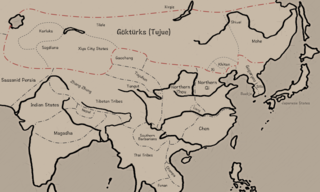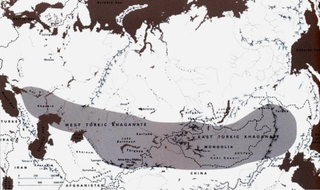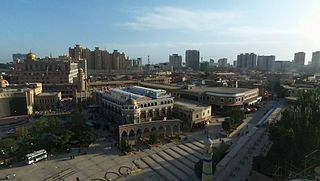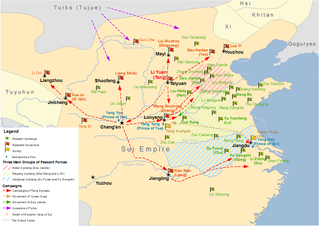 W
WThe Göktürks, Celestial Turks or Blue Turks were a nomadic confederation of Turkic peoples in medieval Inner Asia. The Göktürks, under the leadership of Bumin Qaghan and his sons, succeeded the Rouran Khaganate as the main power in the region and established the Turkic Khaganate, one of several nomadic dynasties which would shape the future geolocation, culture, and dominant beliefs of Turkic peoples.
 W
WThis is a timeline of the Göktürks from the origins of the Turkic Khaganate to the end of the Second Turkic Khaganate.
 W
WThe Eastern Turkic Khaganate was a Turkic khaganate formed as a result of the internecine wars in the beginning of the 7th century after the Göktürk Khaganate had splintered into two polities – Eastern and Western. Finally, the Eastern Turkic power was absorbed by the Chinese Tang Empire.
 W
WThe Second Turkic Khaganate in Bain Tsokto inscriptions. 682-744), was a khaganate in Central and Eastern Asia founded by Ashina clan of the Göktürks. It was preceded by the Eastern Turkic Khaganate (552-630) and then a period of Tang Chinese rule (630-682). The Second Khaganate was centered on Ötüken in the upper reaches of the Orkhon River. It was succeeded by its subject Toquz Oghuz confederation, which became the Uyghur Khaganate.
 W
WAsena is the name of a she-wolf associated with the Oghuz Turkic foundation myth. The ancestress of the Göktürks is also a she-wolf, mentioned yet unnamed in two different "Wolf Tales" recorded by Chinese chroniclers.
 W
WThe Ashina, also known as Asen, Asena, or Açina, were a tribe and the ruling dynasty of the ancient Turkic peoples. It rose to prominence in the mid-6th century when the leader, Bumin Qaghan, revolted against the Rouran Khaganate. The two main branches of the family, one descended from Bumin and the other from his brother Istämi, ruled over the eastern and western parts of the Göktürk confederation, respectively.
 W
WThe Battle of Yinshan was fought in 630 CE near the Yin mountain range close to the city of Dingxiang. Emperor Taizong (598-649) commissioned the famed Tang military officer Li Jing, along with Li Shiji, Wei Xiaojie, Li Daozong, Chai Shao (柴紹), and Xue Wanche (薛萬徹) to attack forces under the command of Illig Qaghan, leader of the Eastern Turkic Khaganate, a nomadic confederation of Turkic peoples based in Inner Asia. The battle ended in defeat for the Göktürks and resulted in the dissolution of the Eastern Turkic Khaganate, which was eventually replaced by the Protectorate General to Pacify the North, otherwise known as the Anbei Protectorate (安北都護府) in 647 CE after the Tang dynasty definitively conquered the Xueyantuo.
 W
WThe First Turkic Khaganate, was a khaganate established by the Ashina clan of the Göktürks in medieval Inner Asia. Under the leadership of Bumin Qaghan and his brother Istämi. The First Turkic Khaganate succeeded Rouran Khaganate as the hegemonic power of the Mongolian Plateau and rapidly expanded their territories in Central Asia. Initially the Khaganate would use Sogdian in official and numismatic functions. Although the Göktürks spoke Old Turkic, the Khaganate's early official texts and coins were written in Sogdian. It was the first Turkic state to use the name Türk politically. Old Turkic script was invented at the first half of the 6th century.
 W
WGrey wolf is a sacred animal and national symbol in Turkic and Mongol mythology.
 W
WKashgar or Kashi, is an oasis city in the Tarim Basin region of Southern Xinjiang. It is one of the westernmost cities of China, near the border with Afghanistan, Kyrgyzstan, Tajikistan and Pakistan. With a population of over 500,000, Kashgar has served as a trading post and strategically important city on the Silk Road between China, the Middle East and Europe for over 2,000 years, making it one of the oldest continuously inhabited cities in the World.
 W
WKul-chur inscription or Küli Čor inscription was an inscription erected in honor of a military leader called Kul Chur of the Xueyantuo. It was erected between 723 and 725.
 W
WThe Old Turkic script was the alphabet used by the Göktürks and other early Turkic khanates from the 8th to 10th centuries to record the Old Turkic language.
 W
WThe Orkhon inscriptions, also known as the Orhon inscriptions, Orhun inscriptions, Khöshöö Tsaidam monuments, or Kul Tigin steles, are two memorial installations erected by the Göktürks written in Old Turkic alphabet in the early 8th century in the Orkhon Valley in Mongolia. They were erected in honor of two Turkic princes, Kul Tigin and his brother Bilge Khagan.
 W
WOrkhon Valley Cultural Landscape sprawls along the banks of the Orkhon River in Central Mongolia, some 320 km west from the capital Ulaanbaatar. It was inscribed by UNESCO in the World Heritage List as representing the evolution of nomadic pastoral traditions spanning more than two millennia. (See List of World Heritage Sites in Mongolia).
 W
WThe Shatuo were a Turkic tribe that heavily influenced northern Chinese politics from the late ninth century through the tenth century. They are noted for founding three, Later Tang, Later Jin, and Later Han, of the five dynasties and one, Northern Han, of the ten kingdoms during the Five Dynasties and Ten Kingdoms period.
 W
WThe Shoroon Bumbagar tomb is an ancient tomb in Zaamar sum, Tov Province, 160km west of Ulaanbaatar, Mongolia about 2.5km north-east from the banks of the Tuul River and close to the 10th-century Khitan town of Khermen Denzh on the banks of the Tuul River. The tomb of Shoroon Bumbagar was never looted and therefore was found to hold far more artifacts including an intact door, many statues and wall paintings of people, dragons and temples, although there was no inscription.
 W
WToquz Oghuz was a political alliance of nine Turkic-speaking Tiele tribes in Inner Asia, during the early Middle Ages. Toquz Oghuz was consolidated and subordinated within the First Turkic Kaganate (552–743) and remained as a nine-tribe alliance after the Khaganate fragmented.
 W
WThe transition from Sui to Tang (613-628) refers to the period between the end of the Sui dynasty and the start of the Tang dynasty. The Sui dynasty's territories were carved into a handful of short-lived states by its officials, generals, and agrarian rebel leaders. A process of elimination and annexation followed that ultimately culminated in the consolidation of the Tang dynasty by the former Sui general Li Yuan. Near the end of the Sui, Li Yuan installed the puppet child emperor Yang You. Li later executed Yang and proclaimed himself emperor of the new Tang dynasty.
 W
WThe Xueyantuo tribe were an ancient Tiele Turkic people and khaganate in Central Asia and Northern Asia who were at one point vassals of the Göktürks, later aligning with China's Tang Dynasty against the Eastern Göktürks.